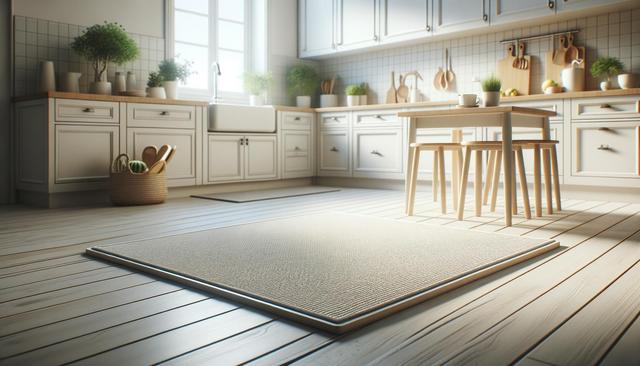Understanding the Benefits of a Water Absorbent Kitchen Mat
A water absorbent kitchen mat serves as a helpful solution for maintaining cleanliness and comfort in one of the most frequently used spaces in a home. Kitchens often experience water spills, oil splatters, and other messes that can lead to slippery surfaces and stains. A mat with high absorbency quickly soaks up moisture, reducing the risk of slip accidents and protecting your floors from damage over time.
These mats also offer an ergonomic benefit, especially for individuals who spend long hours preparing meals or cleaning. Typically designed with a cushioned base, they help alleviate pressure on the feet, knees, and lower back. This makes them a worthwhile addition for home cooks and anyone who values both safety and comfort in their kitchen environment.
- Absorbs water quickly to prevent slips
- Protects flooring from stains and moisture
- Provides cushioning for prolonged standing
Whether you have tile, wood, or laminate flooring, a water absorbent mat acts as a barrier against everyday kitchen messes while offering a more pleasant standing experience.
Materials That Make a Difference
The performance of a water absorbent kitchen mat largely depends on the materials used in its construction. Commonly used fabrics include microfiber, cotton blends, and memory foam. Each of these offers distinct advantages in terms of absorbency, comfort, and durability.
Microfiber is known for its quick-drying properties and ability to trap liquids efficiently. Cotton blends often offer a more natural feel and are machine washable, making maintenance easy. Memory foam, while not as absorbent as microfiber, provides excellent cushioning and is often paired with a water-resistant bottom layer to prevent leaks from reaching your floor.
- Microfiber: Fast-drying and highly absorbent
- Cotton blends: Soft texture and easy to clean
- Memory foam: Exceptional cushioning with protective layers
When choosing a kitchen mat, consider what features matter most for your daily needs. Some mats focus more on comfort, while others emphasize quick absorption and drying.
Design Features for Everyday Convenience
Aside from material composition, many water absorbent kitchen mats come with additional design elements that enhance their functionality. Anti-slip backings are a common feature, providing stability on smooth kitchen floors. This is particularly important in homes with children or elderly family members, where safety is a top priority.
Size and shape also play a role in selecting the right mat. Some mats are long and narrow, ideal for placement in front of sinks or countertops. Others come in rectangular or contour shapes that fit well in tight corners or under kitchen islands. Color and pattern choices allow homeowners to match the mat with their kitchen decor, blending safety with style.
- Non-slip backing for added safety
- Various sizes to suit different kitchen layouts
- Decorative patterns to complement interior design
These features make water absorbent mats not only practical but also adaptable to a wide range of kitchen environments.
Maintaining Your Kitchen Mat for Long-Term Use
Proper care can significantly extend the life and performance of your kitchen mat. Most water absorbent mats are designed to be low-maintenance, but it’s still important to follow the manufacturer’s care instructions. Regular washing helps prevent the buildup of bacteria and odors, especially in mats that are constantly exposed to moisture.
Some mats are machine washable, while others may require spot cleaning or air drying. Avoid using harsh chemicals or high heat during cleaning, as these can degrade the materials over time. For mats with rubber or non-slip backings, it’s also essential to ensure they are fully dry before placing them back on the floor to prevent mold growth or slipping.
- Wash regularly to remove bacteria and odors
- Follow specific care instructions to preserve material quality
- Dry thoroughly before reuse to avoid slipping or mold
By incorporating routine maintenance into your cleaning schedule, you can ensure that your water absorbent mat continues to function effectively and looks good over time.
Choosing the Right Mat for Your Kitchen
With a variety of options available, selecting the right water absorbent kitchen mat depends on several factors including your kitchen’s layout, your personal comfort preferences, and your cleaning habits. If you stand for extended periods while cooking, a cushioned mat with ergonomic support may be ideal. For homes prone to frequent spills, a quick-drying microfiber option could be more suitable.
It’s also important to consider whether the mat complements your kitchen’s aesthetic. Neutral tones offer versatility, while bold patterns can make a decorative statement. Check the mat’s dimensions to ensure it fits the intended space, whether it’s in front of the sink, stove, or prep counter.
- Assess comfort vs. absorbency needs
- Match color and design to your kitchen theme
- Ensure proper fit for your kitchen layout
A carefully chosen mat can enhance both the functionality and appearance of your kitchen, contributing to a cleaner and more comfortable workspace.
Conclusion
Water absorbent kitchen mats are a practical investment for anyone looking to improve safety, cleanliness, and comfort in their kitchen. With a wide selection of materials, sizes, and designs available, there’s a suitable option for nearly every household. By choosing a mat that aligns with your specific needs and maintaining it properly, you can enjoy the benefits of a drier, safer, and more pleasant cooking environment every day.


